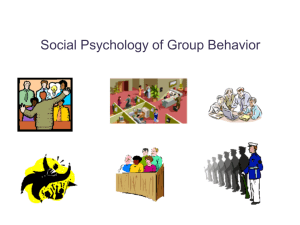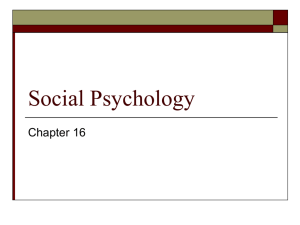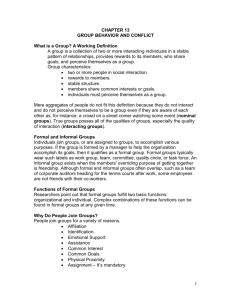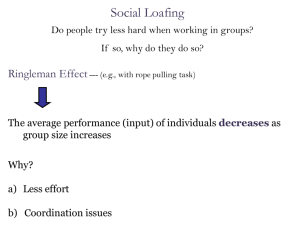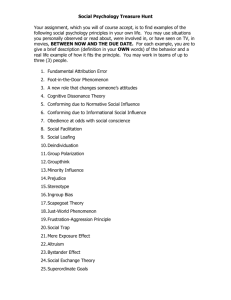Social Psychology of Group Behavior: Presentation
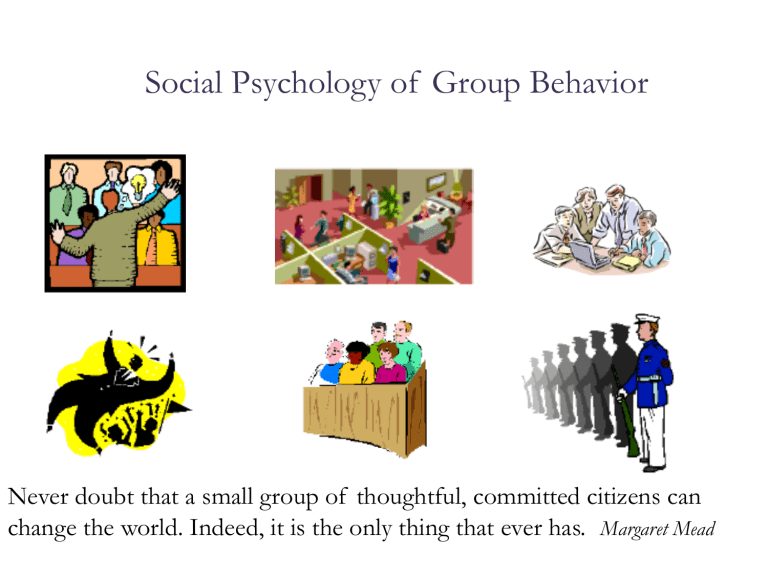
Social Psychology of Group Behavior
Never doubt that a small group of thoughtful, committed citizens can change the world. Indeed, it is the only thing that ever has.
Margaret Mead
Are Groups Good or Bad?
Gustav Le Bon (1895) stated that leaders can manipulate citizens by simplifying ideas, substituting affirmation and exaggeration for proof, and by repeating points over and again. (From: Forsyth, 2010) --- Concept of
“ deindividuation ”
LeBon and Tarde --- Mass hysteria
Does the presence of others help or hinder performance?
Early research by Triplett with bicyclists and fishing reels
Evidence for Social Facilitation (others, acting as competitors, helped performance)
Later studies found mixed effects; the presence of others sometimes helped performance while other studies found that they decreased performance
Why this inconsistency in results?
Zajonic ’ s Theory of Social Facilitation
How does the presence of others affect our performance on tasks?
Zajonic ’ s (pronounced ZYE-unts; 1965) theory of social facilitation argues that the presence of other people increases arousal, which then facilitates dominant, well-learned habits but inhibits non-dominate, poorly learned habits.
Well-learned
(dominant) response
Poorly learned or novel
(non-dominant) response
Arousal caused by presence of others
Social Facilitation
Performance enhanced
Social Interference
Performance hindered
Why is arousal due to the presence of other people?
• Biological (presence alone leads to physiological arousal)
• Evaluation concerns (by others)
• Concentration/Focus
EASY MAZE
Audience
Boxes
Goal
DIFFICULT MAZE
Goal
Audience
Boxes
Start
Floodlight
Start
Floodlight
Two mazes used in experiments on social facilitation with cockroaches (Zajonc et al., 1969)
20
15
10
5
0
45
40
35
30
25
75
70
65
60
55
50
Novel Task (type info backwards with descending
Alone numbers in between)
Well-learned task (type name, city, etc. normally)
Mere Presence
Condition
Experimenter watching
Results of a Study of Mere Presence Effects (Schmitt et al., 1986)
Does the mere presence of another person lead to social facilitation effects?
Schmitt et al. (1986) asked college students to type their names either forward (easy task) or backward (difficult task). Subjects were either alone, in the presence of a watching experimenter, or in the presence of another subject who was wearing a blindfold and earphones.
As the previous graph shows, subjects showed social facilitation effects (that is, less time taken on the easy task, more time taken on the difficult task) even when the person present could not see them, which suggests that the mere presence of another person is somewhat arousing
Social Loafing
Do people try less hard when working in groups?
Does social loafing occur?
Ringleman Effect
--- (e.g., with rope pulling task)
The average performance (input) of individuals decreases as group size increases
Why?
a) Less effort b) Coordination issues
Ringelmann Findings
Individuals
1-7
8-14
15-21
22-28
15-28
Individual
Efforts
(Sum)
Group Effort Group/Individ ual Ratio
764
516
533.7
575.5
1109.2
480
432
435.4
471.2
858.9
.63
.84
.82
.82
.78
Precursor to the Latane et al study (Ingram et al, 1974)
Yelling (& clapping) study by Latane, Williams, & Harkins
Alone
In actual groups
Less individual effort when in groups, even in “ groups ” when no one was present
(but people thought they were)
In pseudo-groups
8
Sound pressure per person
6
10
Potential productivity
Pseudo-groups
Reduced effort
(Social loafing)
Actual groups
Coordination loss
4
2
1 2 6
Group size
Social Loafing on a More Complex Task
Some evidence that people in groups who cannot be identified do better on complex tasks via effect of relaxation (e.g., Jackson & Williams, 1985)
Social Loafing on a More Complex Task (cont.)
More output when individual performance could be evaluated and compared to others
Why less effort (loafing)?
• Expectation that others will try less hard (equity)
• Less social pressure on each individual group member
• Less contingency between individual inputs and outputs (individuals in groups cannot be identified ; anonymous)
Social Loafing Across Cultures
Performance
30
27
24.5
24
21
18
16.5
15
United States
23.3
20.8
23.8
18.5
China Israel
Country
Alone
Group
Kind of Task
Four Kinds of Group Tasks
Description Examples
Additive
Conjunctive
Disjunctive
Divisible
Group members pool or add their efforts
Group members separately perform same subtask (s)
•Tug of war
•Crop harvesters
•Relay Race
•Bowling Team
•Mountain-climbing team
•Quiz game team
•Jury
Group members collaborate to arrive at an
“ either/or, ” “ yes/no ” decision
Group members perform subcomponents of task; a true labor division
•Football team
•Baseball team
•NASA
Also:
• Optimizing vs. maximizing
• Unitary vs. divisible
Example of Groupthink
Link for Film
The Stages of Groupthink
What are the causes and consequences of groupthink?
Antecedent
Conditions
Isolated, cohesive, homogeneous decision-making group
Lack of impartial leadership
High stress
Systems of
Groupthink
Closed-mindedness
Rationalization
Squelching dissent
“ Mindguards ”
Feelings of righteousness and invulnerability
Self-censorship
Consequences
Incomplete examination of alternatives
Failure to examine risks and consequences
Incomplete search for information
Poor decisions
Ways to Improve Group Decision-Making
Leadership style (impartial, use of outside input)
Brainstorming?
Nominal Group Technique
• Define the problem
• Individuals anonymously generate solutions
• Solutions presented to the group (no evaluation allowed)
• Group rates solutions
• Best solution is chosen (vote, consensus)
Other Group Decision-Making Phenomena
Collective Entrapment --- The more effort used to make a decision, the greater likelihood of sticking to that decision (even if it ’ s been shown to be incorrect)
Common Knowledge Effect --- Information held by most group members exerts a stronger impact on final decisions
Participative Decision-Making --- Some Issues
• Time requirement (group decisions take more time)
• Which decisions are made in this manner (all, some, only the most important ones; who decides)?
• Perceptions of leaders are affected (diminished)
• Who participates (everyone, only those who are interested, only those who are capable; who decides)?
• Lowered individual responsibility for decisions made
• High level of leadership skills required
Some Basic Leadership Factors
• Flexibility in leader behavior (style must match the requirements of a given situation such as time frame, group acceptance, decision quality)
• Know their subordinates and provide incentives that match their needs and desires
• Treat subordinates fairly
• Set realistic and challenging goals
• Leaders need to be perceived as important in order for employees to get rewards
• Guarantee that employee job performance leads to getting desired rewards
Perceived Fairness in Groups
Perceptions of Justice (Equity)
• Distributive Justice --- Judgments about the fairness of outcomes/rewards given (e.g., money, promotions) relative to others
• Procedural Justice --- Perceived fairness of the procedures or processes used
• Interactional Justice
• Interpersonal -- Perceptions about how people are treated (e.g., caring, consideration) by decision makers
• Informational --- Data regarding why the decision(s) need to be made
Acceptance of smoking ban
6
Interpersonal Justice Effects
Interpersonal Justice Level
Low
High
More interpersonal justice lead to greater acceptance, especially among heavy smokers
5.9
5.6
5
4.8
4.3
4.1
4
3
2.7
2
Heavy Light
Level of Smoking
None
Deindividuation: Getting Lost in the Crowd
The loosening of normal constraints on behavior when people are in a crowd, leading to an increase in impulsive and deviant acts
Trick or Treat Study
Identified Anonymous
Individual
Group More candy taken in this condition
Why does deindividuation occur?
• Anonymous (feel less accountable for individual behavior)
Current example = Internet trooling
• Focus is outside oneself (increases the likelihood that one will conform to group norms)
Jim Jones leader of the
("Peoples Temple")
The Jonestown Massacre
November 18, 1978 – Most of the 912 people in a compound named “ Jonestown ” in British Guyana died from voluntarily drinking Kool-Aid mixed with cyanide, sedatives, and tranquilizers. It was depicted by Jim
Jones as an act of "revolutionary suicide."
Why Did People Join?
• Charasmatic leader
• Desperate, sense of purpose, utopia
• Initial commitment technique (FITD)
• Role of severe initiation (viewed as positive)
Why Did They Stay?
• Threats/punishment
• Limited access to information
• Little communication between members
(fallacy of uniqueness)
• Self-justification (e.g., Cognitive dissonance)
• Jonestown situation perceived as inevitable
(no escape) viewed as positive (ex. Brehm study; future notice of food or person)
Long-lasting effects!
Self-blame
Tragedy of the Commons
The C ommons Dilemma : Everyone takes from a common pool of goods that will replenish itself if used in moderation but will not if overused
Therein is the tragedy. Each man is locked into a system that compels him to increase his herd without limit - in a world that is limited. Ruin is the destination toward which all men rush, each pursuing his own interest in a society that believes in the freedom of the commons. (Hardin, 1968)
“ Capitalism recognizes only private property and free-for-all property. Nobody is responsible for free-for-all property until someone claims it as his own. He then has a right to do as he pleases with it, a right that is uniquely capitalist. Unlike common or personal property, capitalist property is not valued for itself or for its utility. It is valued for the revenue it produces for its owner. If the capitalist owner can maximize his revenue by liquidating it, he has the right to do that."
[ Apostles of Greed , pp. 58-59]
Objects
Tragedy of the Commons
.
.
.
.
.
.
.
.
.
.
.
.
• The person who grabs the most objects (after 10 seconds) wins the game
• After 10 seconds has passed, any remaining objects will be doubled
Overfishing
About one-third of all fishing stocks worldwide have collapsed. If current trends of overfishing and pollution continue, the populations of just about all seafood face collapse by 2048
(Science, 2006)
World Water Supply
Water covers roughly 70 percent of Earth's surface, but only 2.5 percent of it is freshwater, which humans need for irrigation, drinking water, and other everyday uses.
Source: http://www.pbs.org/wgbh/nova/worldbalance/eart-nf.html
Deforestation
According to the World Resources Institute, more than 80 percent of the Earth ’ s natural forests already have been destroyed. Up to 90 percent of West Africa ’ s coastal rain forests have disappeared since 1900.
Map Source: http://www.kap.zcu.cz/opory/mv1_2/deforestace%20a%20desertifikace.pdf
Energy Usage
Carbon Dioxide
Emission
Surface Air Temperature
Increase
Global energy consumption and carbon dioxide (CO
2
) emissions are likely to increase by more than 50% over the next 20 years, with much of the growth centered in the developing world, according to the latest international energy forecast by the U.S. Department of Energy ユ s Energy Information Administration
